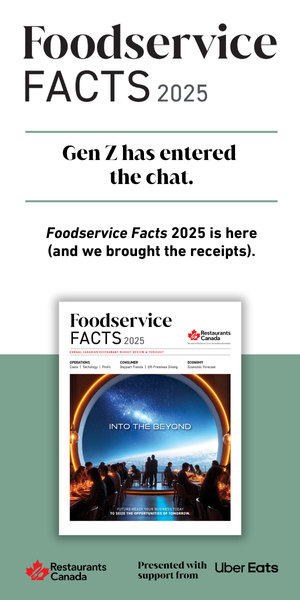TIPPING THE SCALES: A tax compliant solution to restaurant gratuity management has arrived.
The search for a compliant solution to Canada Revenue Agency (CRA) standards for restaurant gratuity
management has ended with the arrival of Atlas Direct Tips.
In the bustling world of Canadian restaurants, operators face a hidden financial peril that often goes unnoticed: the tax implications of gratuities. As patrons generously tip their servers, these gestures of appreciation for employees can translate into a tax liability for the employer. Not knowing the rules can cost business owners thousands of dollars they cannot afford.
As seen in recent court cases involving the handling and management of gratuities, the Canada Revenue Agency (CRA) casts a watchful eye on tips, with two key classifications: “Direct Tips” which are exempt from CPP and EI, or “Controlled Tips” which are NOT exempt from CPP and EI.
A Direct Tip System simply proves that tips were voluntarily paid from the customers to employees, that these tips were put in the control of the employees at the end of each shift, and that the employees were in charge of the division model. In essence, the employer has not exercised any control or direction over the pooling and distribution of the tips.
If the employer is not able to prove they exercised no control or direction over the tips, such as having autogratuities (i.e. 18 per cent gratuity on tables of 6+), or the employer holds on to the tips after the shift, or if the employer is the one who divides and distributes the tips, then these are considered Controlled Tips, which makes them subject to CPP and EI to which both the employer and employee must contribute (a total of 7.5 per cent each). If an employer is not able to prove that their tip model was Direct, they will be held responsible for CPP contributions and EI premiums on the tip amounts for both portions (total of 15.22 per cent). This is over $30,000 of penalties per every $1M of sales for potentially every year under audit.
James Rhodes, Principal of Taxation Lawyers, is a seasoned tax expert with extensive experience in guiding hospitality businesses through the intricacies of tipping legislation. A trusted advisor to Restaurants Canada, James Rhodes authored the Association’s tipping toolkit and has taken an active role in counseling restaurant owners on the treacherous waters of tax compliance regarding gratuities and helping them sidestep the legal pitfalls that lurk beneath the surface.
He has long believed that while there have been a few solutions that have come close, none have cleanly stepped over the 100 per cent threshold in meeting the CRA’s definition of automated direct tips, until a
recent breakthrough by the tech company, Atlas. To achieve this level of certainty, gratuities (including those collected via digital payments, which are the overwhelming majority) must be entirely managed by the employees themselves and must be paid out within the same work shift in which they are earned.
The restaurant industry recently caught a break, with the release of a new product from Atlas, a restaurant management system technology company that has launched Atlas Direct Tips, an automated and CRA-compliant gratuity and division system that deposits tips directly into employee bank accounts. “I believe it’s time to fly,” James confirms. “Atlas is 100 per cent safe because it works on a system that ensures that tip amounts are put in the control of employees at the end of their shift. By getting their tips on time, they’re meeting CRA’s test, which is a really high test. CRA has said they want the employee to get all the gratuities by the end of the shift, and that’s great if you have one employee, but what happens when you have teams of employees, and some leave early and some of those teams aren’t in control of a read? I see restaurants with bartenders where they’ll have one till open, but the other bartenders go home early. The last bartender is the one that closes and figures out the gratuity. How do you meet CRA’s threshold when the reality of the situation is extremely complex? How do you meet that test? Atlas Direct Tips meets that test by managing the essential timelines for money movement. So, no matter what, those employees have received their gratuities on time.”
The Atlas algorithm calculates the value of tips expected using historical data and manages the complexity of money movement, ensuring the business is always putting the tips in control of the employees at the correct time. Once those calculations are automatically done based on the tipping model selected by employees, Atlas transfers the tips directly into employee bank accounts. The prepayment concept Atlas uses allows restaurants to estimate the value of tips they expect staff to receive based on historical data for that day or shift. The company then pays the anticipated amount to Atlas, which effectively holds those funds in trust until the end of the shift, when the employee entitlements can be calculated. Once those calculations are automatically done based on the restaurant’s tipping model, Atlas transfers the tips directly into employee bank accounts.
“Atlas is actually acting on behalf of the employee gratuity committee,” James points out. “To satisfy the CRA requirements, the employee gratuity committee acts on behalf of the employees, dividing and distributing the funds based on a fair and transparent model. Atlas helps employees and employers manage all of this, including all transactions to deposit tips directly into the bank account of employees based on any tip division model.”
Beyond meeting CRA compliance terms, Atlas also ensures compliance with what each of the provinces are asking of restaurants. “Due to my work on Ontario Ministry of Labour issues,” James adds, “Atlas is already ahead of what the Province of Ontario is expected to legislate for restaurants and tip pools in the upcoming year.”
Atlas delivers the flexibility needed to integrate the full range of employee tip committee-managed models, which can be incredibly diverse, to calculate the correct tip amounts. This is, in part, a result of the work James has done in creating highly specific and detailed tip models on spreadsheets for his clients and the insights the Atlas team gained from his experience and used to develop the technology. “It’s the most flexible program out there to be able to figure out gratuity distribution as decided and managed by the employees electronically. It effectively automates that spreadsheet so, when the gratuities come in, it’s like those gumball machines. The tips work their way down through the digital version of the spreadsheet to figure out each employee’s entitlement. And then it pushes that money out to their individual bank accounts.”
The advent of Atlas is a double-edged sword for James, who has spent so much of his time on this issue on behalf of his industry clients. “I just really believe in it,” he states. “I really like the leadership team and I know they’re going to make a difference when it gets out into the wider market. The weird thing is that it’s the destruction of my business. I was just joking with them that restaurants really don’t call me anymore. One of the services I routinely provided was creating a spreadsheet for employee gratuity committees and now Atlas does it automatically. So, I dinosaured myself, I think.”
Restaurants Canada has been actively looking for ways to bring in the right experts and the right tools to not only address this pernicious issue, but with an eye on finding a solution that is not only compliant, but simple to use. “Restaurants Canada has long recognized the serious risk to restaurant operators related to gratuity management,” confirms Kelly Higginson, Restaurants Canada President and CEO. “We have been closely monitoring the market and keeping this issue a top priority, seeking out partners with the experience and capacity to solve this sleeping liability for our overburdened industry. We’re thrilled that Atlas has met CRA’s threshold and is available to Restaurants Canada members at a special rate and to all Canadian foodservice operators. This has been a long time coming, and it’s a huge benefit to the industry.”
Download Restaurants Canada’s Tip and Gratuity Compliance Guide for Canadian Restaurateurs,
authored by James Rhodes of Taxation Lawyers here.
Restaurants Canada Webinar On Demand
Watch: Rules for Tips & Grats: What employees and employers must know to learn more about Atlas Direct Tips and how it can automate tip division, distribution and compliance with James Rhodes, Principal, Taxation Lawyers, Afshin Mousavian, CEO and Co-Founder of Atlas and Turi Mercuri President and Co-Founder, Atlas.









